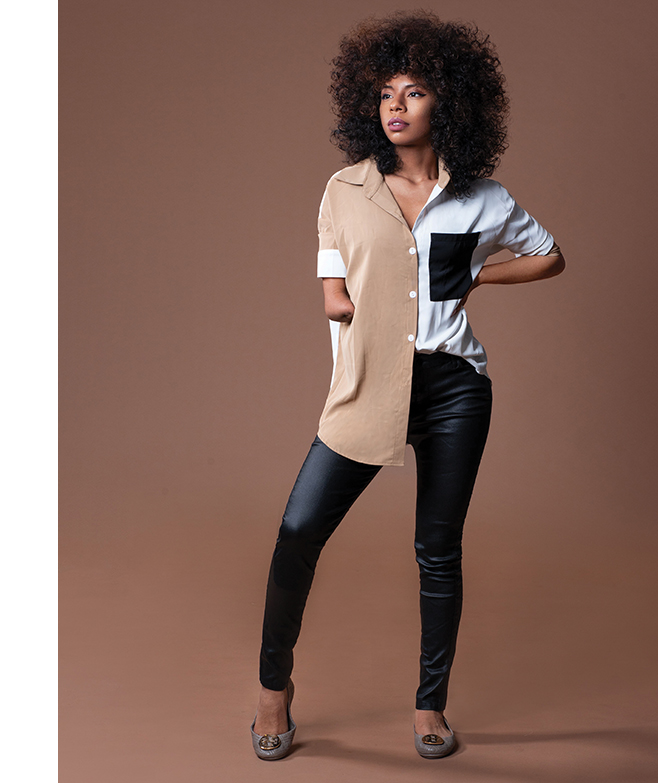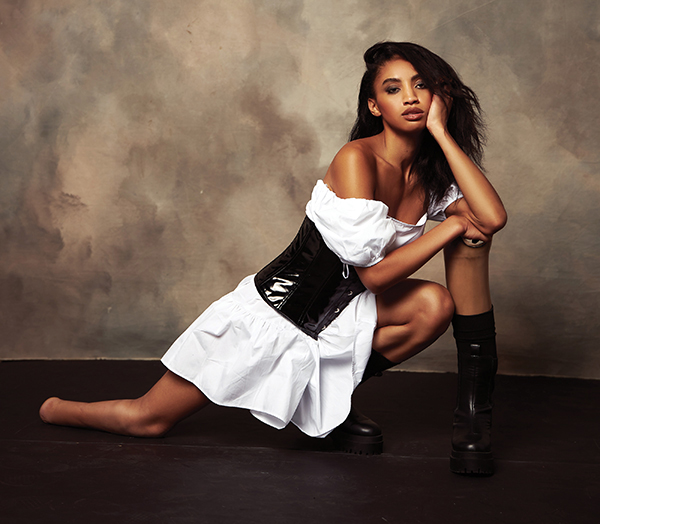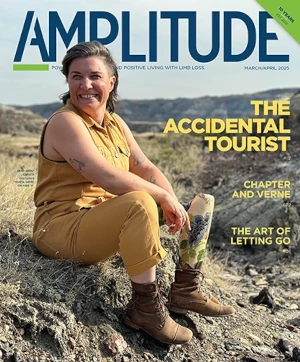Kayla Maria G is blazing new trails in the modeling world as a limb-different person of color.
By Rene Agredano
On a sweltering July afternoon in Florida, a steady stream of fashion influencers pack into a showroom to kick off Miami Swim Week 2021. The party vibe heats up with infectious club music and dazzling lights that draw everyone’s attention to the stage. A stunning bikini-clad woman stands in the spotlight, ready to start the show. Right on cue, she sashays down a water-filled runway, performing a jaw-dropping dance routine that makes Shakira’s moves look boring.
The fashion world hasn’t stopped talking about Kayla Maria G ever since. Neither has the limb-difference community. A congenital below-elbow amputee, Kayla made a bigger splash than any person with a disability ever has at Miami Swim Week, the beachwear industry’s answer to Paris Fashion Week.

“Being asked to not only model but open up @prettylittlething’s Miami Swimwear Week is an iconic moment for me,” Kayla wrote on Instagram (her handle is @kaylamaria.g). “Inclusion campaigns are the first step to normalization, and [I’m] extremely proud of being part of that barrier break.”
Breaking barriers is becoming a habit for Kayla Maria G. In just four short years, the 25-year-old Afro-Latina model and dancer has skyrocketed to fame in the fashion and dance worlds. Her star began rising when A-list musicians Cardi B and Marc Anthony reposted her Instagram dance routines on their channels. Those shout-outs helped Kayla’s own social media audience swell to 144K+ followers on TikTok and 50K+ followers on Instagram, eventually leading to a modeling contract that thrust her into a well-deserved spotlight. Iconic brands such as Hilfiger, Kurt Geiger, Pretty Little Thing, and Nike now eagerly seek her out for their campaigns.
It’s a life Kayla dreamed of while she was growing up. But until recently, she didn’t think it was possible.
“Because of how society is, I didn’t think I was ‘allowed’ to do the things I really wanted to do, which was dancing and modeling,” she says from her home base in New York City. “I never saw anyone like me growing up.”
Born to Break Barriers
Kayla was born with a below-elbow limb difference caused by amniotic band syndrome. She was different from her peers and endured some hard times as a result. But her mother and grandmother always reminded Kayla that being unique was no reason to miss out on opportunities. “You are not allowed to say the words ‘I can’t,’” her mom, Cyndy, always said. “You can always do it. You’ve just got to do it differently.”
Kayla’s childhood was jam-packed with dance classes and other activities that helped her gain confidence. Dance was her first love, but she never seriously thought of it as a potential career path. Because she didn’t have any role models in dance or fashion, it just didn’t occur to her that a limb-different person could occupy the spotlight. So when it came time to select a college major, she didn’t go after a dance degree. Instead, she opted for a path that would prep her for a nine-to-five desk job in human resources.
Kayla continued taking dance classes in her free time, though, and her passion for it never diminished. Everything changed one day when a dance teacher stopped her after class. “So who do you want to tour with?” the instructor asked. It was a light-bulb moment for Kayla, who had never permitted thoughts of becoming a professional dancer to enter her mind. She was too stunned by the question to answer at first. “I was like, ‘Am I allowed?’” she laughs. Then her mother’s voice echoed in her thoughts, and she said to herself: “Why not? Why can’t I be that person?”
Once she said “yes” to her dream of dancing professionally, Kayla made a U-turn in life. She left college in 2017 and threw herself into her new career, determined to broaden her dance styles and break into modeling. She took dozens of classes to help expand her repertoire, doing whatever she could to improve her dancing and build her confidence. Before long Kayla started teaching classes herself. Then she began posting videos on social media, sharing not only her moves and her personality but also her self-assured embrace of limb difference in a world that’s often cruelly judgmental.
Once she said “yes” to her dream of dancing professionally, Kayla made a U-turn in life. She left college in 2017 and threw herself into her new career, determined to broaden her dance styles and break into modeling. She took dozens of classes to help expand her repertoire, doing whatever she could to improve her dancing and build her confidence. Before long Kayla started teaching classes herself. Then she began posting videos on social media, sharing not only her moves and her personality but also her self-assured embrace of limb difference in a world that’s often cruelly judgmental.
“I grew up being told that I was incapable of completing tasks by society,” she wrote in one Instagram post. “There’s a moment every day that I have to disprove this statement.”

Kayla’s body-positive message brought thousands of fans to her feeds. It also attracted the attention of Zebedee Management, an all-inclusive agency that’s as groundbreaking as she is. Launched in 2017 by sisters Laura Johnson and Zoe Proctor, Zebedee represents an extraordinarily diverse group of more than 500 models in four countries. Their roster includes people with disabilities as well as transgender, nonbinary, and plus-size individuals. The sisters started out with the goal of promoting sensitive representation of disabled people and redefining perceptions of beauty, and Zebedee’s rapid growth proves the power of that vision: Johnson says the firm is four times busier than it was before the pandemic.
Kayla applied to Zebedee the moment she learned about them. It was a career-defining move. “I have my agency to thank,” she says, “because they were sending me to casting, and brands looked at my Instagram because of them.”
“When we were first in contact with Kayla, we were wowed by her beauty,” says Johnson. “She has a very unique and fresh look. She is a fantastic model. Her dance experience gives her that extra something in front of the camera.”
Major retail and entertainment clients have discovered Kayla’s dual talents. As a dancer, she has appeared in videos produced by Disney+ and the rapper Common. Her burgeoning career as a model has included featured roles in campaigns by Hilfiger, Nike, Pretty Little Thing, and other industry-leading brands. Occasionally she wears her bionic arm in her shoots, but it’s never the main focus. When the spotlight shines on Kayla, her talent and beauty take center stage.
Authenticity In and Out of the Spotlight
As both a person of color and a person with a disability, Kayla Maria G is exceptionally rare in mainstream fashion and media. But her growing visibility is creating a path for others to follow, and it’s helping many of them find the courage to pursue their own dreams.
One of those true believers is fashion model Lyric Mariah, a Chicago native who, like Kayla, grew up with a congenital limb difference caused by amniotic band syndrome. “I consider [Kayla] a role model,” she says, “because I don’t see so many people of color like me embracing their bodies the way that she does. Being able to see someone just like me was incredible.”
The 24-year-old Mariah now represents well-known brands such as Dolls Kill and Savage X Fenty. But until recently, she struggled to carve out her niche in the fashion world. Competing for work against body-normative models was a roller-coaster experience. Mariah stuck with it through the ups and downs with single-minded determination. “I tried to leave very little room for discouragement in my head, even if it didn’t work that way,” she says. “I kept reminding myself that if God told me to be here and do this, then I got this.”
It took years for her persistence to pay off. After many attempts to get established, Mariah received a contract offer from the Select modeling agency. “My heart just fell out of my body,” she says. “I just could not believe it, and at the same time I could totally believe it.” The agency is opening doors that Mariah has been knocking on for years, ones she has dreamed about walking through since she was a teenager. But she cautions that modeling jobs don’t automatically add up to better self-esteem—especially for people with limb difference.
“Loving yourself is a daily job,” she says. “It’s all day, every day, but it is truly a job only you can do.”
Mariah and Kayla were both fortunate during childhood to have strong-willed mothers who encouraged independence and inner strength. As adults, they’ve found new sources of support to renew and sustain their self-assurance. And they both take satisfaction in projecting their confidence outward, not only to encourage others with limb difference but also to change the way society perceives bodies that don’t conform to conventional definitions of beauty.
“At a young age, my mother taught me that just because I’m different, it doesn’t take away anything that I have to offer,” says Kayla. She delivers the same message to students in her dance classes, where Kayla helps people of all shapes and sizes discover joy in their own bodies. “I can see the immediate impact I make on a student,” she says, “regardless of their age or whatever they want to do with dance.”
She wants to open her own dance studio someday. Until then, Kayla is committed to showing other people how to unlock the possibilities within themselves. “I just want to continue to break barriers,” she says. “I want everyone to feel like it’s possible to chase after every single one of their dreams, because it’s possible! Why not try and see what happens?”
More Amplitude articles about models with limb difference
“Five Amputee Models in Runway of Dreams’ NYFW Show,” September 8, 2021
“Limb Loss Doesn’t End Model’s Dream,” July/August 2020
“Four Up-and-Coming Amputee Models,” June 24, 2020



